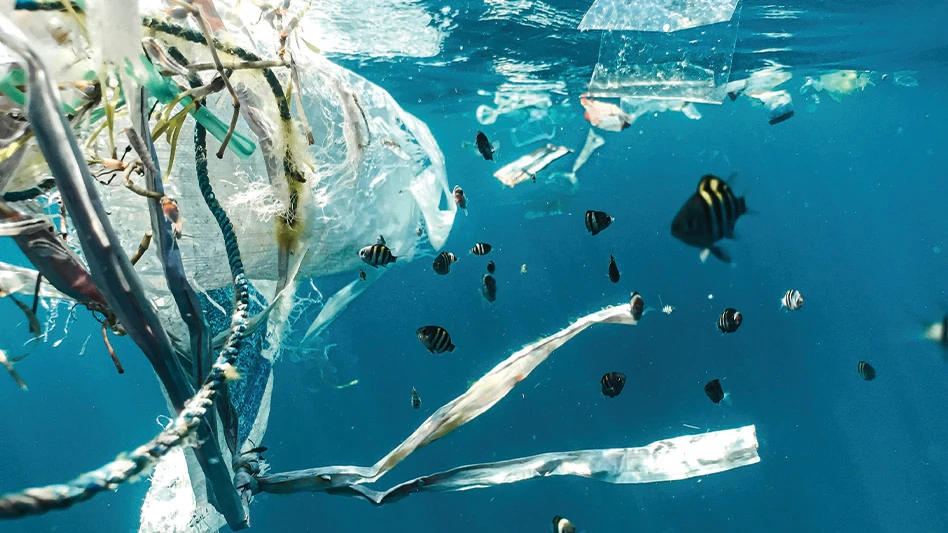
Photo courtesy of CleanHub
A new report has been released by Germany-based ocean plastic recovery startup CleanHub that highlights ocean plastic pollution this year, as well as a look into its complex origins and what the future holds as plastic production rises.
Launched ahead of Earth Day, the “How Much Plastic Is In The Ocean?” report analyzes industry data on the amount of plastic that is in the oceans, with sections focusing on plastic bags, straws, bottles and microplastics, and the main ways that plastics enter oceans. It also looks at the countries that produce the most plastic scrap and the state of ocean garbage patches.
“Ocean plastic pollution is one of the biggest environmental issues of our time,” CleanHub Vice President of Marketing Nikki Stones says. “It continues to grow to shocking levels and affects not only marine life but people, too, through its impact on the entire ecosystem. Products must be created with their end-of-life in mind, and we need to build better infrastructure to deal with the huge amounts of waste.
“At CleanHub, we believe that ocean plastic pollution is solved on the land, not the sea. By introducing effective waste management where it doesn’t exist and transforming waste materials into something useful on a much larger scale. This way, we reduce our reliance on new materials and utilize wase instead of dumping it. Without these solutions in place around the world, ocean pollution will only continue to increase.”
According to the report, 14 million tons of plastic enter the world’s oceans annually, and by 2050, in terms of weight, there will be more plastic than fish in the ocean.
On the seafloor, the report claims there are up to 11 million tons of plastic and 10,000 times more plastic particles than on the surface, with microplastics making up more than 14 million tons. On the surface, it is estimated that there are 358 trillion microplastic particles.
The report estimates that 80 percent of ocean-bound plastic (OBP) comes from Asian countries, although much of this is shipped from abroad. China, the United States and India produce the most plastic scrap per year, and India, China and Brazil “mismanaged the most waste,” showing an imbalance between production and waste management.
The report says poor waste management infrastructure and overspilling landfills are the key reasons so much material ends up in the oceans, though in terms of waste produced per person, the U.S. ranks first with 105 kilograms of plastic thrown away yearly, followed by the United Kingdom at 99 kg per year.
CleanHub says much of the data around exact plastic scrap exports is omitted by some countries, making it difficult to determine the exact amount of material thrown away by each country. As of 2020, Europe was the biggest exporter of plastic scrap as well as the biggest importer.
CleanHub’s research notes that the fishing industry is responsible for around 10 percent of ocean scrap, which includes fishing nets, traps and lines that get lost. Some of the nets are kilometers long and it can be difficult to know how many are on the ocean floor as many are weighed down by dead marine life—including animals as large as sperm whales—caught in them.
The report claims plastic bags are a major ocean pollution issue. They break down into microplastics and/or are ingested by marine life, and it is estimated that 56 percent of all marine life has ingested plastic. Annually, CleanHub says up to 300 million plastic bags end up in the Atlantic Ocean alone.
Despite efforts to restrict single-use plastic bags from some countries, including the U.S., U.K. and China, CleanHub says single-use plastic production rates have increased. It notes about 137 million tons of single-use plastics were produced from fossil fuels in 2021, and this number is expected to rise by another 17 million tons by 2027.
The report says up to 8.3 billion plastic straws are found on worldwide shorelines, with around 7.5 million on U.S. shores alone, making up about 4 percent of plastic scrap by piece, though their weight is so small that they only amount to 2,000 of the nearly 9 million tons of plastic entering oceans annually.
Similar to other plastic products, CleanHub says it is hard to know how many plastic bottles are in the ocean, though in the U.K. it has been found that for each mile of beach there are 5,000 pieces of plastic and 150 plastic bottles.
The report also looks at ocean garbage patches, which are the culmination of ocean scrap around whirlpool-like currents called marine gyres. There are five main patches—one in the Indian Ocean, two in the Atlantic Ocean and two in the Pacific Ocean. The largest is the Great Pacific Garbage Patch, estimated to be three times the size of France.
CleanHub says there are global efforts being made to reduce ocean-bound plastic, including the High Seas Treaty, which was signed by several countries in 2023 with the aim of turning 30 percent of oceans into protected areas by 2030 to protect marine life and reduce harmful fishing practices. The United Nations also introduced the High Ambition Coalition to End Plastic Pollution that encourages countries to stop plastic pollution by 2040 through a circular economy model. However, neither initiative specifically deals with existing plastic scrap.
Latest from Recycling Today
- Orion ramping up Rocky Mountain Steel rail line
- Proposed bill would provide ‘regulatory clarity’ for chemical recycling
- Alberta Ag-Plastic pilot program continues, expands with renewed funding
- ReMA urges open intra-North American scrap trade
- Axium awarded by regional organization
- Update: China to introduce steel export quotas
- Thyssenkrupp idles capacity in Europe
- Phoenix Technologies closes Ohio rPET facility





